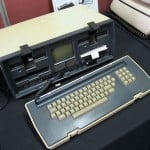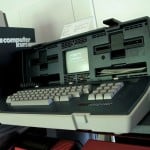The first portable computer was unveiled 30 years ago yesterday. It was introduced by Adam Osborne and was called the Osborne 1. This groundbreaking device quickly gained popularity before the company unfortunately went bankrupt just eighteen months after its launch.
If you look at the photo below, it is hard to believe that this is actually a portable computer, especially when you compare it to today’s portable computers, tablets, and even smartphones, which are capable of performing many of the tasks of modern-day computers.

The guys over at Technologizer have a great write-up on the world’s first portable computer and the company that made it. It is definitely worth a read.
The Osborne 1: A Revolutionary Device
The Osborne 1 was a revolutionary device for its time. Released in April 1981, it featured a 5-inch display, dual 5.25-inch floppy drives, and a full-sized keyboard. Weighing in at 24.5 pounds, it was considered portable because it could be carried to different locations, even though it was quite bulky by today’s standards. The Osborne 1 ran the CP/M operating system and came with a suite of software applications, including the WordStar word processor and the SuperCalc spreadsheet program.
Despite its size and weight, the Osborne 1 was a significant step forward in making computing accessible to more people. It was priced at $1,795, which was relatively affordable compared to other computers of the time. This affordability, combined with its portability, made it a popular choice for business professionals who needed to work on the go.
The Rise and Fall of Osborne Computer Corporation
The success of the Osborne 1 was short-lived. The Osborne Computer Corporation faced several challenges that led to its downfall. One of the main issues was the rapid advancement of technology. Competitors quickly released more advanced portable computers, making the Osborne 1 seem outdated. Additionally, the company made a critical mistake known as the “Osborne Effect.” This occurred when Adam Osborne prematurely announced the next generation of Osborne computers, causing a significant drop in sales of the existing model as customers decided to wait for the new version.
The company also struggled with production and supply chain issues, which further hampered its ability to compete in the rapidly evolving computer market. Despite these challenges, the Osborne 1 remains a significant milestone in the history of computing.
Portable computers have certainly come a long way in the last 30 years. Today’s laptops are incredibly lightweight, powerful, and versatile. They feature high-resolution displays, long battery life, and advanced connectivity options. Tablets and smartphones have also become essential tools for both personal and professional use, offering capabilities that were unimaginable three decades ago.
As we look to the future, it’s exciting to imagine what advancements the next 30 years will bring. With the rapid pace of technological innovation, we can expect even more powerful and portable computing devices. Concepts like foldable screens, augmented reality, and artificial intelligence are already beginning to shape the future of computing.
The Osborne 1 may seem like a relic of the past, but it paved the way for the portable devices we rely on today. It serves as a reminder of how far we’ve come and how much potential there is for future advancements in technology.
Source
Latest Geeky Gadgets Deals
Disclosure: Some of our articles include affiliate links. If you buy something through one of these links, Geeky Gadgets may earn an affiliate commission. Learn about our Disclosure Policy.


